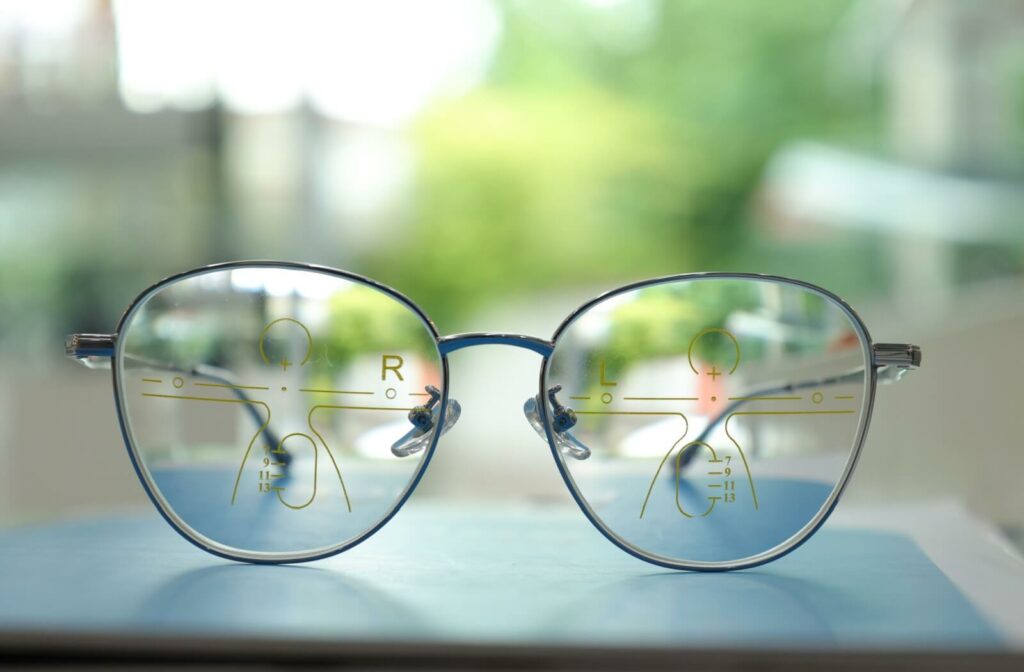Growing older is a privilege that brings about a wealth of wisdom and experiences, and also visual changes.
Presbyopia is a refractive error that develops naturally as we grow older, affecting our ability to focus on nearby objects. This condition will develop regardless of whether an individual already has an ongoing refractive error, like myopia or hyperopia.
Progressive lenses are often the favored lens choice when correcting for presbyopia. Their unique multifocal design offers vision correction at far, intermediate, and near distances, eliminating the need for switching between multiple pairs of glasses.
All About Progressive Lenses
Progressive lenses are a type of multifocal eyeglass lens designed to correct vision at multiple distances. These lenses provide a gradual transition from near to intermediate to distant vision.
Unlike traditional bifocals or trifocals, progressive lenses offer a seamless gradient of increasing lens powers, allowing for clear vision at all distances without a line disrupting the lens, separating different prescription zones.
In progressive lenses, the top of the lens is corrected for distance viewing. As you move your eyes downward through the middle portion of the lens, the prescription gradually changes to accommodate intermediate distances, perfect for tasks like computer work. Finally, the bottom part of the lens is corrected for close-up activities such as reading.
Progressive lenses are most commonly used to correct presbyopia.
Presbyopia occurs naturally as we grow older, it typically develops at around age 40 and progresses over time. Almost everyone will experience some degree of presbyopia, even if they already have an existing myopic or hyperopic prescription.
The condition occurs because our eye’s natural lens becomes less flexible as we age, making it harder to adjust its shape to focus on nearby objects. This leads to difficulty reading small print, threading needles, or performing other tasks that require close-up vision. Hence, progressives are a simple and effective method for correcting this refractive error.
Comparing Progressive, Bifocal, and Single Vision Lenses
When choosing the right lenses, understanding the differences between progressive, bifocal, and single-vision lenses is helpful.
Single-vision lenses are designed to correct vision at one specific distance, whether near, intermediate, or far. These lenses are a great option for individuals requiring one simple vision prescription. Because of their simple design, they lack the versatility of multifocal lenses.
On the other hand, bifocal lenses provide two distinct optical powers, one for distance and one for near vision, separated by a visible line. These are a popular alternative to progressive lenses.
Because there’s no intermediate optical power in bifocals, this abrupt change in vision leads to discomfort when switching focus between two distances, especially for those who aren’t yet used to bifocal’s unique lens design.
Progressive lenses, however, eliminate these issues with their smooth, gradual transition between multiple focal points. This gradual transition aims to provide the wearer with a natural visual experience. Wearers can easily shift their focus from near to far, without the disorientation that bifocals can cause.
The Benefits of Progressive Lenses
Progressive lenses provide a multitude of benefits that make them an appealing choice for those experiencing presbyopia.
One of the main benefits of progressive lenses is their convenience. With just one pair of glasses, you can perform a variety of tasks without constantly changing eyewear. This is particularly useful for those who have active lifestyles or jobs that require frequent shifts between different visual tasks.
Unlike bifocals or trifocals, progressive lenses transition smoothly across different lens powers, eliminating the abrupt ‘image jump’ associated with lenses that have distinct segments. This makes adapting to transitions between near and far easier on the eyes and reduces strain.
Progressive lenses look like regular single-vision lenses, without the visible lines or segments seen in bifocals, making them an attractive option for those who prefer a more modern, contemporary look.
Progressive lenses also support a healthy visual posture, particularly for those who spend extended periods in front of digital screens. By offering precise vision at intermediate distances, like a computer monitor, they help reduce neck and shoulder strain, and eye fatigue.
Tips for Adjusting to Progressive Lenses
While the benefits of progressive lenses are numerous, their unique multifocal lens design requires individuals to adjust to their new lenses. This is incredibly common, especially for first-time wearers.
Initially, progressives can result in mild dizziness, visual distortion, or discomfort, as your visual system learns to navigate these distinct optical zones.
Rest assured, with consistent use, the initial discomfort will subside as your visual system adapts to these new lenses. Adapting to progressive lenses will require some patience, so, here are some tips to help ease the transition:
- Wear Your Glasses Consistently: It’s critical to wear your progressive lenses consistently, rather than switching between multiple pairs of glasses. This helps your eyes and brain adapt to the different focal areas more quickly.
- Adjust Your Head Movement: Unlike single-vision glasses, progressive lenses may require slight adjustments to how you move your head. Try tilting or lowering your head slightly when reading or looking at something up close to utilize the correct part of the lens.
- Be Patient: Allow yourself time to adjust. It can take a few days for some individuals to become fully accustomed to progressive lenses. Consistent use and practice will encourage this process.
- Give Yourself Time to Experiment: Experiment with different activities like reading, computer work, and walking around to fully understand how to leverage the different prescription areas of your lenses effectively.
If discomfort continues after implementing these tips, visit your optometrist, as they may recommend further adjustments to your glasses.
Well-fitted glasses that sit correctly on your face make the world of a difference. This helps maintain proper lens alignment with your line of sight.
Browse our Selection of Frames
Picking out a new pair of frames is one of the most exciting parts of eye care. Regardless of the frames you select, you’ll be able to experience the benefits of progressive lenses for vision correction.
Connect with our team at Total Focus Optometry, to browse our selection of frames and find your next pair of eyeglasses!




